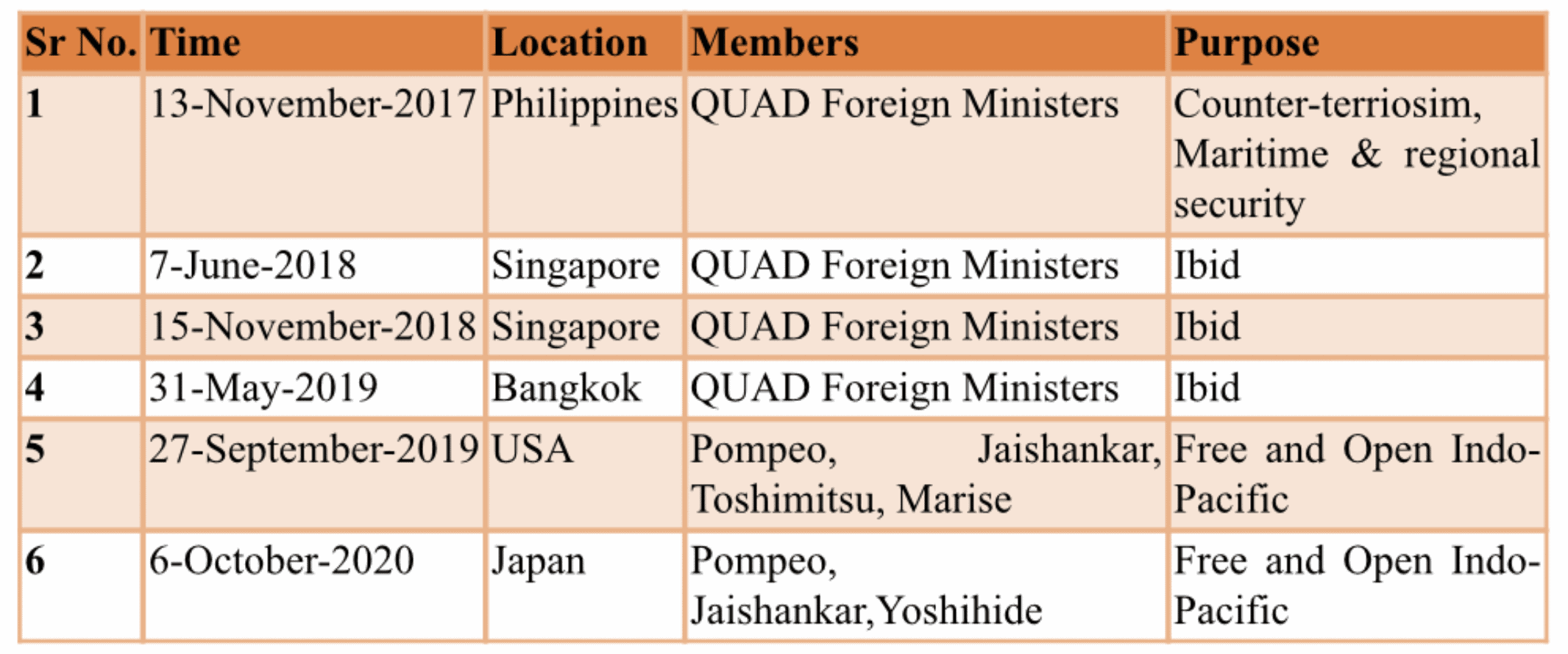By Rana Danish Nisar
“QUAD” or “Quadrilateral Security Dialogue” is an informal juxtaposition on security between four US powers, India, Japan and Australia.

Initially this configuration was organized in the year 2004, during the tsunami period in order to strengthen the coordination in the context of relief efforts in very devastated areas. In the year 2007, Japanese Prime Minister Abe invited his like-minded leaders, namely US Vice President Dick Cheney, Indian Prime Minister Manmohan Singh and Australian Prime Minister John Howard to establish a joint venture and joint military naval exercises in the wider Asia-Pacific region. The first naval exercise, with the name of Malabar drills, was inaugurated by the four countries after mutual consent. According to strategic and security analysis, the main reason behind the formation of the QUAD was to contain China’s growing power in the wider Asia-Pacific region.
With the threshold of the twenty-first century, and the emergence of the American military presence in Iraq and Afghanistan, the 9/11 event is regarded by political and security experts in the frame of American growing eagles in the wider Asia-Pacific, or ” soft containment “of China in the region, juxtaposing the US with its other democratic allies. Indeed, the United States wants a powerful bulwark with the help of its allis against the anti-American forces, and the clear evidence is the shift in the mood of the US towards India, from “alienation” to “commitment” and finally with the “strategic partnership and NSSP -2004 “. Soon after the end or disintegration of the Soviet bloc, an abrupt change in interstate relations of two past “foreign democracies” occurred, and both said “goodbye” to the “misunderstanding” of the past, shaping their relationship in a new direction. In the late 1990s, or the threshold of the twenty-first century, the US army commander Claude Kicklighter played a vital role in the goal of rebuilding military-military relations between India and the United States. In the year 2005, the two countries signed the “New Framework for Cooperation between India and the United States” under the main leadership of US Secretary of Defense Rumsfeld and his Indian counterpart Parnab Mukherhjee.
The civil-nuclear cooperation and the agreement between India and the United States, with the sharing of advanced weapons, missile technologies, are monitored by security experts to make India able to counter China. Besides India, the United States initially signed the Trilateral Security Dialogue (TSD) in the year 2002 with Japan and Australia, which was updated at ministerial level in the year 2005. The purpose of the TSD was to make possible the inclusion of Japan and Australia in America’s global strategy against terrorism and the fight against nuclear proliferation.
In the year 2007, the TSD was converted into the Quadrilateral Initiative (QI) and India joined the TSD with the aim of promoting peace under the slogan of “Democratic Peace”. According to critics, this step from TSD to QUAD is effectively an anti-Chinese alliance and is definitely aimed at countering China and its growing military and political influence in the wider Asia-Pacific. Additionally, some critics call it as the US counter-strategy to counter the SCO and the formation of the Asian variant of NATO. In this regard, the Bush administration has strengthened its relations not only with the New Delhi hawks, but has established the chain of alliances in the “Washington-centered ASEAN region” against China.
After Bush, Obama, as new president of the United States of America launched his “Pivot to Asia” strategy, regarded by strategic and security analysts as purely anti-Chinese. America officially declared China as its competitor. Obama has strengthened in-depth relations with India, Australia and Japan, making them stronger thanks to his “alliance” or “containment” strategy against China. Due to the charismatic leadership of Obama, Australia, India and Japan have returned to be part of the “QI”. Also, in 2012, the Japanese Prime Minister Abe proposed an idea of security under the name of “Asia’s Democratic Security Diamond”, before the second mandate of the Obama administration. Based on his proposal, Japan announced the “Free and Open Indo-Pacific” initiative in the year 2016.
Trump, after his arrival at the Oval House, visited Japan, showing his willingness to the “Free and Open Indo-Pacific” initiative in 2017. In the same year, the Quad countries met at the “ASEAN” and at the “East Asia Summit”, giving a format to this “Quad” initiative. Since 2017, Quad members have been met six times.
During the covid-19 pandemic, the QUAD countries enhanced their in-depth juxtaposition and their efforts to counter this deadly disease. Currently, some Asian and Western academic experts have argued that “QUAD” is a replica of “NATO” with the new name of “ASIAN-NATO”. The North Atlantic Treaty Organization (NATO) was inaugurated by the United States of America in the year 1949, in the frame of its containment strategy against its rival USSR. During a meeting with the former director of the CIA, M.Pompeo presented his proposal to move from “QUAD” to “Asian-NATO”, with mutual shared objectives, win-win benefits, and jointly profits for all in the Asian geopolitical chessboard. In October 2020, the Sri Lankan Foreign Ministry showed his concern regarding the growing militarization of the Indian Ocean region, under this growing QUAD juxtaposition.
Interestingly, the concept of “Asian-NATO” is regarded by India as WIN-WIN for its strategic goals and long hegemonic dream of “Akhand-Bharat” or “Greater-India”. It may be possible that under this new concept of “Asian-NATO”, India will increase the projection of Indian offensive power in the wider Asia-Pacific, particularly against the weaker states. Furthermore, “Asian-NATO” is not a new concept. Indeed, also Bush proposed this idea and admited the importance of India as a powerful and growing major power, with common strategic interests with the United States of America.(1) Furthermore, the United States wants a deep military-military relationship with India on the bases that it shares US values in the context of democracy and national interests.(2) Some analysts have argued that this “Asian NATO” concept is a replica of the “Southeast Asian Treaty Organization (SEATO)” which was formed by the United States in the year 1954 against the USSR during the climate of “COLD WAR”. (3)
In the American view, India could play its best role as the leader of the “Asian NATO”. According to Indian analysts, no other country understands the Asian NATO criteria required by Washington or the same strategic perspectives as India. They justify their request on the basis of India’s position, seaports and air bases, democratic values and common interests with the United States that are prerequisites for such an alliance. America has recognized that access to these bases in the Indian Ocean not only allows it to exercise [its power of] command and control of the seas across that ocean, but is also extremely valuable for operations and missions since. Middle East to Southeast Asia with control over Chinese naval projects in the Indian Ocean. Under the newly elected president of the United States, Joe Biden shows his willingness to improve the “free and open Indo-Pacific”.
On February 18, 2021, the United States, Australia, Japan and India all agreed to vigorously oppose China’s growing peaceful influence in the wider Asia-Pacific. Together with the Western associates, namely the United Kingdom, France, Germany and Canada, they show their willingness to deploy their presence in the Indo-Pacific region. More recently, on March 15, 2021, US Secretary of State A. Blinken and Defense Secretary L. Austin arrived in Japan and started the Security Advisory Committee (SCC), under the name of “TWO-PLUS – PLUS “, with the aim of improving defense relations with Japan. Shortly after his visit to Japan, Austin arrived in India on March 19, 2021 and met with Indian Prime Minister Modi, Indian National Security Advisor Ajit Doval, and Defense Minister Rajah Singh. According to analysts, this emergency visit was amed to win the trust of Asian allies.
In summary, the reason behind the launch of the “Quadrilateral Security Dialogue” or QUAD “is to counter the growth of China. The “Asia-NATO” concept, with the inclusion of “QUAD”, may be possible in the near future, but bringing all parties together on one table could be the biggest challenge for President Biden. Furthermore, in “QUAD”, “Asia-NATO”, “Indo-Pacific” or possibly “Pivot to Asia 2.0”, it is possible that there are clashes of national interests among US associates. Perhaps countering China is not India’s first priority. Because China is the most powerful neighbor and the largest economy. India has in-depth economic relations with China which is its largest market. India is also a big market for China. Furthermore, India will never indulge in a broader conflict between the US and China in the South China Sea. Each state has its own national interests and never compromises them
Time will tell what the future of “QUAD” or “Asia-NATO” will be. Will the US convince other states to choose the single “QUAD” platform or the “Asia-NATO” platform? Now there is no more COLD WAR “and the traditional balance of power has changed with the times. The world has changed and states are more sensitive to their national interests.
Rana Danish Nisar The author is a PhD (International Relations) Student at the School of Politics and International Studies (SPIS). He holds Mphil in (International Relations), Masters in (Pakistan Studies), and Masters in (International Relations) degrees. He won acceptance Harvard Project for Asian and International Relations HPAIR (USA), 2017. His research interests are broadly in South Asian Affairs, South Asia Geo-Politics, India-Pakistan Relations, South Asian Nuclear Politics, US and South Asia, Indian Ocean, Security studies, South Asian developments studies.
(The views expressed in this article belong only to the author and do not necessarily reflect the editorial policy or views of World Geostrategic Insights).









